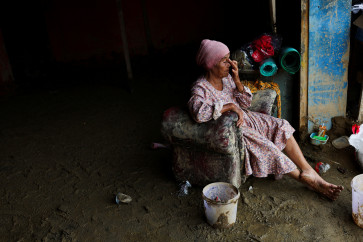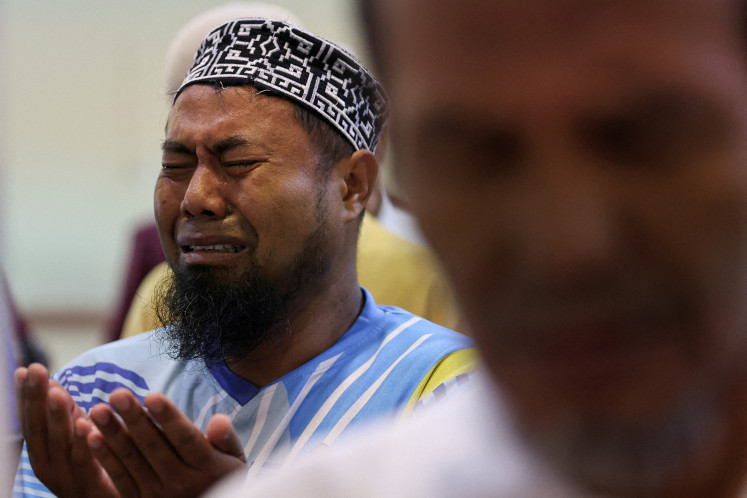Popular Reads
Top Results
Can't find what you're looking for?
View all search resultsPopular Reads
Top Results
Can't find what you're looking for?
View all search resultsGerard Mosterd: Expressing identity through dance
Courtesy of Gerard MosterdGerard Mosterd was born in 1964 and grew up in Holland, the son of an Indonesian mother and a Dutch father
Change text size
Gift Premium Articles
to Anyone
C
span class="caption" style="width: 398px;">Courtesy of Gerard MosterdGerard Mosterd was born in 1964 and grew up in Holland, the son of an Indonesian mother and a Dutch father.
Gerard is a dancer and choreographer and is currently in Indonesia presenting a contemporary dance performance entitled A Soldier’s Tale with a stellar cast – Eko Supriyanto, Martinus Miroto, Sri Qadariatin, (an actress and dancer from Teater Garasi in Yogyakarta) and Jamaluddin Latif as the story’s narrator.
Eko and Miroto starred together in Garin Nugroho’s film Opera Jawa and both are well known as dancers in Holland and other European countries.
A Soldier’s Tale was conceived in 1918 by Igor Stravinsky, who also composed the music. He collaborated with C. F. Ramuz to write the scenario.
The idea was to create a piece that would be adaptable to any cultural context and could be performed cheaply anywhere. It tells the story of a man who sells his soul to the devil in exchange for a book that will tell him how to get all that he desires – recalling the story of Faust.
This was Stravinsky’s spirited response to hard times, cut off by the effects of the Great War from his family estates and royalties from publishers.
When The Rite of Spring was performed by Diaghilev’s Ballets Russes, choreographed by and starring the great Nijinsky, it caused a riot at its premiere at the Theatre des Champs-Elysses in Paris in 1913.
“Eko is something like a Javanese Nijinsky with his wildness,” observed Gerard.
Perhaps Stravinsky would be fascinated if he could see the Javanese interpretation of his work.
Gerard has studied many different versions of the piece that have been presented around the world. However, he has re-imagined it through his own modern, European sensibility and his Indonesian other half, and has brought an ambiguity to the previously archetypal characters: the Devil, the Soldier and the Princess.
He says, “I have chosen to break with its conventional morality. Everybody has good and bad within them. Anybody could be the Soldier, the Princess or the Devil. You will see that the Devil is actually among us.”
The music is played by the seven-member Dutch Chamber Music Company from Holland, conducted by Azjan Tien.
This is the 10th year in a row that Gerard has come to Indonesia to create and tour his productions. He has also expanded the activities of his production company, Kantor Pos, to other countries in Southeast Asia, including the Philippines, Thailand, Singapore, Malaysia and also Japan.
“Indonesia is very culturally active, but is underdeveloped and there is no government support for the arts. There are only a few places where theater and culture are available, such as Teater Garasi in Yogyakarta and EKI [Exotica Karma Iwangga] in Jakarta,” Gerard explained.
Gerard has traced his ancestry to an Austrian named Flohr who came to Indonesia and married a woman from Solo. Gerard has grandparents from Kediri. His other grandmother was from Manado and he has a grandfather of mixed heritage who worked for the Solo palace.
His artistic activities reflect his own search for personal identity.
“In my artistic work I am always trying to connect Asia and Europe – to analyze and identify both. Russia is a kind of missing link between Europe and Asia and Stravinsky was Russian. I like his incredibly farsighted globalist idea that A Soldier’s Tale could be adapted to any cultural context.”
“I haven’t performed onstage in a long time, but I used to dance pieces by Stravinsky, including Petrushka and The Rite of Spring. These famous works are very challenging for a dancer, because you have to count, count, count, count. Stravinsky is a very mischievous composer because he knows how to put you on the wrong foot all the time. He winked when he composed it. If you think it’s going to be a ‘four’, it’s a ‘five’. This music is very difficult for a dancer, and especially for Javanese dancers, who are accustomed to a totally different kind of music.”
Gerard first came to Indonesia in 1999 when he was in his thirties. He picked up the Indonesian language very easily, although his family never spoke it at home.
“I have a close relationship with my Indonesian mother, who came to Holland at the age of thirteen and lived in a very Indonesian way until she was married. She was not allowed to speak Indonesian, but she lived and thought as an Indonesian, so I have always felt very Indonesian too. She experienced the years of the Second World War in Indonesia and was not allowed to dance, although she wanted to. She is very artistic and loves classical music and ballet.
“Sometimes, being half Indonesian has been difficult when living in a monoculture, as was Holland when I was young. People even used discriminatory language about me, such as calling me a monkey because I looked more Asian than I do now. Also, it means one can see several different perspectives when the people around you cannot. Beginning in the seventies, immigrants started to arrive in Holland and now it is a multicultural society so now it is much easier for me.
“When I was at primary school in Amersfoort, I was very studious, collected fossils and I showed an artistic sense by drawing. I didn’t enjoy football and thought the other boys ridiculous in their enthusiasm for it. But I was a champion in athletics – the high jump was my forte. The school director advised my mother to find a gymnastics group for me to join for my physical development, but she enrolled me in a dance school. My mum had seen me doing dance improvisations in the garden. She saw that I moved in a traditional Javanese style and that I had a sense of spiritual energy within. I began to learn academic dance and disciplined movements, but I loved the interpretation part. I’m a born improviser.”
During his career, he danced with international companies in Basel, Antwerp, Paris and London. In 1991 he worked with Li Cunxin (whose autobiography has been filmed as Mao’s Last Dancer), and many other internationally famous dance stars and choreographers.
Gerard says, “I am very fond of my Indonesian family and I always felt that I wanted to contribute to Indonesian society. The best way I can do it is by doing what I am trained for. When I walk in the street here, I feel that I may be seeing my Indonesian relatives. I must still have many family members here in Indonesia.
A Soldier’s Tale will be performed in Jakarta at Erasmus Huis on August 19th and 20th.










